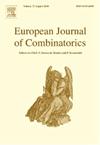On the Δ-edge stability number of graphs
IF 0.9
3区 数学
Q1 MATHEMATICS
引用次数: 0
Abstract
The -edge stability number of a graph is the minimum number of edges of whose removal results in a subgraph with . Sets whose removal results in a subgraph with smaller maximum degree are called mitigating sets. It is proved that there always exists a mitigating set which induces a disjoint union of paths of order 2 or 3. Minimum mitigating sets which induce matchings are characterized. It is proved that to obtain an upper bound of the form for an arbitrary graph of given maximum degree , where is a given constant, it suffices to prove the bound for -regular graphs. Sharp upper bounds of this form are derived for regular graphs. It is proved that if or the induced subgraph on maximum degree vertices has a -edge coloring, then .
论Δ-edge图的稳定数
图G的Δ-edge稳定数esΔ(G)是去掉图G的最小边数,得到的子图H为Δ(H)=Δ(G)−1。去除后得到的子图的最大度较小的集合称为缓解集。证明了总存在一个缓和集,它能诱导出2阶或3阶路径的不相交并。对诱导匹配的最小缓解集进行了表征。证明了对于给定最大次为Δ的任意图G(其中c为给定常数),得到形式为esΔ(G)≤c|V(G)|的上界,足以证明Δ-regular图的上界。对于正则图,导出了这种形式的明显上界。证明了当Δ(G)≥|V(G)|−23或最大度顶点上的诱导子图具有Δ(G)边着色时,则esΔ(G)≤≤≤≤≤≤≤|V(G)|/2;
本文章由计算机程序翻译,如有差异,请以英文原文为准。
求助全文
约1分钟内获得全文
求助全文
来源期刊
CiteScore
2.10
自引率
10.00%
发文量
124
审稿时长
4-8 weeks
期刊介绍:
The European Journal of Combinatorics is a high standard, international, bimonthly journal of pure mathematics, specializing in theories arising from combinatorial problems. The journal is primarily open to papers dealing with mathematical structures within combinatorics and/or establishing direct links between combinatorics and other branches of mathematics and the theories of computing. The journal includes full-length research papers on important topics.

 求助内容:
求助内容: 应助结果提醒方式:
应助结果提醒方式:


